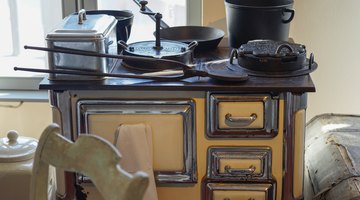How to Convert an Antique Gas Stove to Propane
Table of Contents
With the right help from the pros, it’s easy to convert your antique gas stove to propane, creating an appliance that can serve generations to come.

Antique stoves bring charming character to modern kitchens, but they are more than just gorgeous centerpieces. They can also serve as fully functioning appliances. Depending on the type of antique stove you want, you may need to convert it from natural gas to propane. For example, if you have recently moved to an area that uses propane and you can’t bear to leave behind your beloved antique, with the right precautions, equipment and labor, a conversion is possible.
Reason for a Conversion
The main job of a conversion is to resize the stove’s gas injector so that it releases the correct amount of pressure. Natural gas is lower in pressure than propane, so the orifices through which gas escapes are larger. With the conversion to propane, which is higher in pressure, you don’t want too much gas to leak through that larger orifice. If the gas injector is incorrectly sized, it could lead to hazardous situations including carbon monoxide poisoning or dangerously large flames. Proceed with the proper amount of care to ensure a safe and effective conversion.
Do Some Digging
First, conduct some research on your antique stove. If you already have one that you are looking to convert, gather as much information as possible about its specs. Some old stoves were designed to handle both gas and propane and already contain adjustable parts. In that case, you might just need simple tools like a wrench or a conversion kit.
Other stoves may require a more complex job, and more parts including new or resized orifices or regulators. If possible, contact the stove manufacturer. They may be able to provide you with a conversion kit or the parts you will need. If the manufacturer is unavailable, a trusted technician or an expert at your local hardware store may also be able to help. An antique appliance store can be another great resource.
If you don’t already have an antique stove, decide on the era first, then start looking into models that will be easy to convert. The easiest type would be one originally designed for both types of fuel since it would be less likely to need additional parts.
Decide If You Can DIY
Once you have figured out what you will need to convert your stove, decide if this is a job you can do yourself. If possible, check with the stove manufacturer: some manufacturers require that a licensed contractor perform the job. Even if a contractor is not a requirement, only the most experienced DIYers should attempt a stove conversion on their own. It’s a potentially dangerous job and must be done correctly. Since each stove model is slightly different, a professional should assess the situation.
Convert Your Stove
If you feel confident about doing the conversion on your own, the first step will be replacing the regulator if it is not already convertible. First, make sure the electrical power is disconnected and the gas supply to the appliance is turned off. Be aware of any gas leaks when you move the appliance. When you are sure it is safe, unscrew the old regulator and replace it with a propane regulator.
Next, you may need to adjust or replace the size of the burner orifices. On some antique stoves, they are adjustable and you can screw them inwards to create smaller holes. Other models are not adjustable and you need to replace them entirely.
Finally, you may need to reset the oven's thermostat. If you have a stove designed for both fuels, you will see a screw on the thermostat knob with two labels: NG for natural gas, and LP for liquid propane. Make sure the screw is set to the propane setting.
When to Contact the Pros
If your stove manufacturer requires a professional to complete the conversion, or if you're not sure you are up for the job, call in a licensed contractor. Reach out to a trusted plumber and ask for someone with stove conversion experience.
If you need a conversion kit and/or other parts that you are unable to obtain from the stove manufacturer, ask the contractor which kit you need and where you can buy it. Kits are often available at your local hardware store or via several online retailers. The kits differ depending on the stove, so make sure you consult with a professional before purchase.
References
Writer Bio
Rachelle Dragani is a freelance writer based in Brooklyn. Her work has appeared in several publications including TIME Magazine, Esquire, Popular Mechanics, Futurism, and Jezebel.
More Articles


